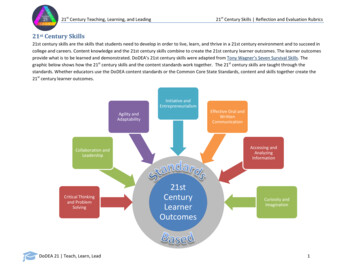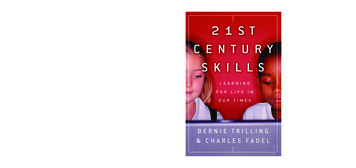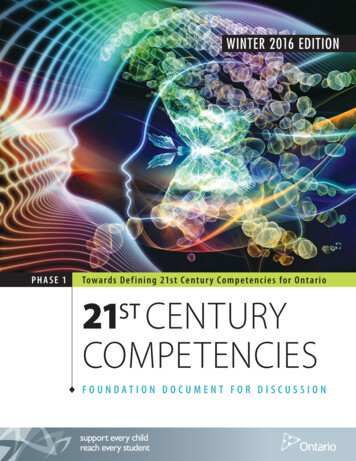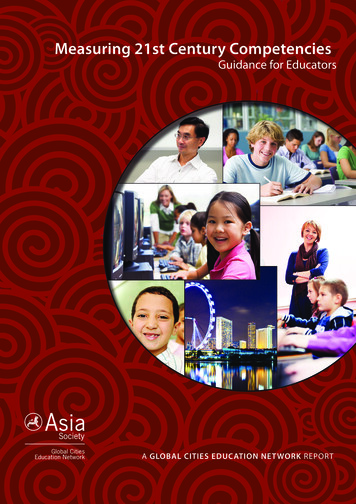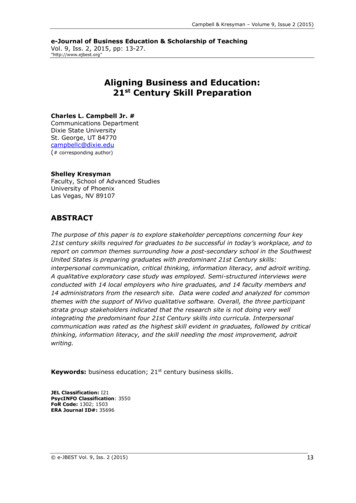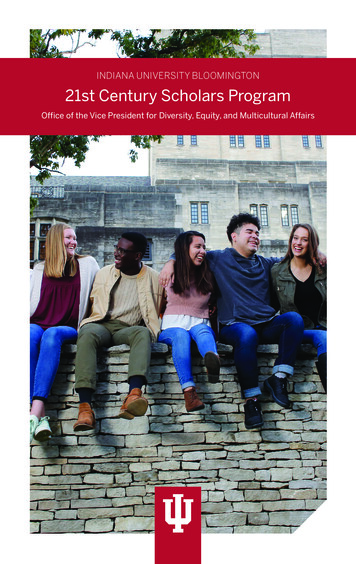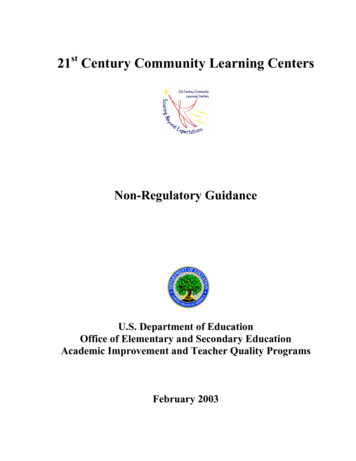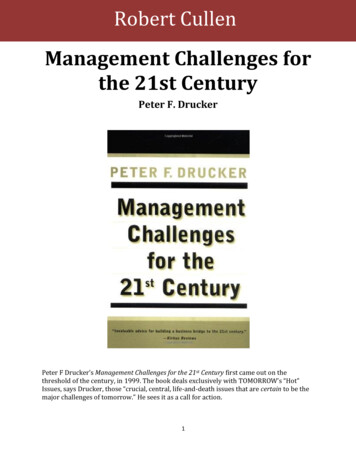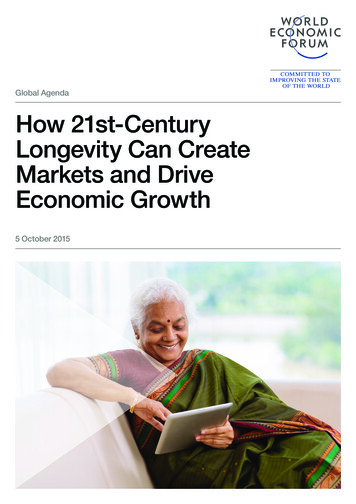
Transcription
Global AgendaHow 21st-CenturyLongevity Can CreateMarkets and DriveEconomic Growth5 October 2015
How 21st-Century Longevity Can Create Markets andDrive Economic GrowthA World Economic Forum White Paper5 October 2015A Series DocumentThe views expressed in this White Paper are those of the author(s) and do not necessarily represent the views of the WorldEconomic Forum or its Members and Partners. White Papers are submitted to the World Economic Forum as contributionsto its insight areas and interactions, and the Forum makes the final decision on the publication of the White Paper. WhitePapers describe research in progress by the author(s) and are published to elicit comments and further debate.
ContentsIntroduction . .2The Evolution of Emerging Markets . .4Examples of Companies that Have Recognized the Inherent Market Potential . 6Challenges for Sustaining Growth in the Future . .10Conclusion .101
IntroductionThe Great Awakening: The 21st Century’s Formative Market OpportunityIn 2012, the World Economic Forum published Global Population Ageing: Peril or Promise.1 In thisseminal work, the Forum’s Global Agenda Council on Ageing Society highlighted the revolutionaryconsequences of worldwide population ageing. The authors drew attention to the dynamic demographictransformations upending all aspects of social and economic life and the need to rethink the2assumptions that underpin our behavioural norms, social expectations, and policies and institutionswithin the context of a world with more people over 60 than under 15 years of age.Further, the authors recognized that the vehicles that have enabled population ageing – breakthroughsin healthcare and sanitation, mass urbanization and modernization – are unsustainable withoutsignificant changes to the paradigm. Innovations in healthcare, among others, can be credited formaking once unimaginably long lives the norm, but lasting ways to finance them must be found. Andwhile many cities, workplaces and homes have fostered a healthier ageing experience for largenumbers of global baby boomers, cities and communities must now become instruments to furtherextend healthy ageing into the 80s, 90s and even 100s in all regions of the world.The World Economic Forum publication meaningfully contributed to the ongoing global conversationabout worldwide population ageing. Two years earlier Standard & Poor’s issued its own clarion call: “Noother force is likely to shape the future of national economic health, public finances and policy-making3as the irreversible rate at which the world’s population is ageing.” The Organisation for Economic Cooperation and Development (OECD), G20 and Asia-Pacific Economic Cooperation have joined theranks of the World Health Organization (WHO), the International Labour Office (ILO), the UnitedNations Population Fund (UNFPA) and others to engage on the subject. Even so, the McKinseyInstitute’s recent No Ordinary Disruption contends that population ageing has only begun to emerge as4a “global force breaking all the trends”.For all the talk of “crisis” and “demographic cliffs,” many business leaders, policy-makers, nongovernmental organizations, academics, economists and others are recognizing that population ageingcan be, given the right strategic framework, a supremely powerful market driver.Evidence from the private sector is beginning to mount. Major global corporations – including Bank ofAmerica Merrill Lynch, Nestlé Skin Health, BlackRock, BMW, Intel, GE, Novartis, Aegon, Discovery andPfizer – have embedded “ageing” as a key strategic driver of their commercial goals. Smallercompanies like Aeon and Home Instead Senior Care are realizing tremendous growth through thesame strategy. Yet it is not only a question of commercial goals. Equally, these global businesses havepositioned ageing as a lever for attracting and retaining top talent, as well as building out frameworks ofsustainability and shared value.Even more specifically, Nestlé has recently announced that it will open Skin Health Investigation,5Education and Longevity Development (SHIELD) centres in major cities across the globe to focus oninvestigating, educating and training for a “life-course of healthy skin”. Cardinal Health has madeproducts and services directed to "alternative sites of care", increasingly important with an ageingpopulation and the need to innovate around how chronic disease is treated. JP Morgan Chase and6Aegon each have very recently opened new research centres on retirement and longevity. Fujitsu islaunching its elder-designed Raku-Raku smartphone in Europe, following the successful market pick upin Japan. Pfizer continues its creative web-based campaign, “Get Old”. Home Instead Senior Care isreinventing the role of professional caregiver globally to enable more and more seniors to have thefreedom and choice to stay at home with best quality care. Discovery, through its Vitality programme,has built an innovative approach to promote longevity and quality of life as part of its life insuranceprogrammes. And, in June 2015, BlackRock, the largest asset manager in the world, released its ownwhite paper, “Unlocking the Longevity Dividend: How Longer Lives are Changing Retirement, Investing7and the Economy”.2
What is more telling is that ageing is becoming a market imperative throughout pop culture. Who wouldhave expected that Hollywood and the fashion industry – so long the exclusive preserve of the young –would embrace ageing? Yet Women’s Wear Daily noted last year that designers and retailers would8only “ignore the 21 billion boomer market at their own peril”. And a survey of recent Oscar winnersand nominees shows that the silver screen is no longer off limits to silver actors.As the private sector moves to capture the market opportunities, public policies are needed to addressageing and enable further innovation. Some examples where public policies can help create thehospitable environment might include flexibility in labour markets for the inclusion of all ages; incentivesfor silver entrepreneurship and ongoing employment for those currently in 20th-century retirementcategories; and pension and education reforms that are built for sustainability in a world where peoplelive to 100 years of age and where there are more old than young. Not least would also be areaffirmation of the critical importance of adequate national policies to ensure pharmaceuticals, devicesand technology that would enable the continued progress of healthy ageing and active, productive andhappy people.Approaches to flexible ageing policies are being addressed by a number of intergovernmentalorganizations, including the WHO, the ILO, the UNFPA, the OECD, the G20, the World Bank and suchinternational civil society entities as the Global Coalition on Aging, the International Federation onAgeing, HelpAge International and the International Longevity Centre Global Alliance. There are manyother think-tanks addressing the challenges andopportunities of older populations. Eachorganization is building on the recognition thatpopulation ageing is a 21st-century imperativeQUITE SOON, THE WORLD WILL REACH Athat requires a substantial and finely calibratedRECENTLY UNIMAGINEABLE MILESTONEresponse.IN THE HISTORY OF HUMANITY: BY MIDIn October 2015, the WHO released its first-everCENTURY, THERE WILL BE MORE PEOPLE9world report on ageing and health. This shouldON THIS PLANET OVER 60 THAN UNDER 15establish a basis for ageing to become a majorstrategic platform of global public health for itsYEARS OF AGE.next five-year plan. The report builds on themomentum already under way through theWHO’s work leading the Age-Friendly Cities initiative, as well as the guidance on non-communicablediseases. The ILO monitors support to ageing, old-age pensions and social security health through its10recurrent World Social Protection Report, as well as other publications, such as on ageing and long11term care. The G20 has just issued “Principles on Silver Economy and Active Ageing”. The OECD, for1213its part, has put together a set of groundbreaking reports on ageing and big data, the silver economyand – before long – ageing and the digital economy.The demographic data is inarguably compelling. Quite soon, the world will reach a recentlyunimaginable milestone in the history of humanity: by mid-century, there will be more people on thisplanet over 60 than under 15 years of age. In many OECD countries, this reality will arrive far soonerand for some is already here. The once exceptional prospect of “growing old” has become the norm. Associeties modernize and urbanize, birth rates throughout the world are plummeting. Already some 80countries have fertility rates below replacement levels and the number is growing alongsidemodernization. Depopulation is accelerating, resulting in a profound demographic reshuffling of theglobal age structure with more old than young.Many mistakenly believe that ageing is principally a phenomenon in industrialized nations. In fact,14currently, emerging markets are experiencing the most dramatic impacts of ageing. What took acentury to unfold in Europe, Japan, the United States and other G7 nations is transpiring in only afew decades in China, Brazil, India, Turkey and a host of other developing and emerging marketcountries. It will surprise few that Japan is placing ageing at the centre of its 2016 G7 leadershipagenda or that one of the EU’s key 2020 growth goals is related to healthy and active ageing. But3
many would not have predicted that China would position ageing high on the agenda of its 2016G20 leadership.Nevertheless, despite this profound andinspiring set of activities designed to capture thepotential of an ageing population, nooverarching framework unites these individualefforts into collective action. No one body hasemerged to take the mantle of leadership byarticulating a framework for understanding,addressing and executing a global ageingstrategy that will ensure promise in place ofperil.IN THE US, FOR EXAMPLE, BY 2017AN ASTONISHING 70% OFDISPOSABLE INCOME WILL BE INTHE HANDS OF THOSE OVER 60.15With its mandate “to invent, innovate and dare to move forward fast” and its convocation ofpublic and private cooperation, the World Economic Forum is uniquely positioned to assume amajor leadership role in global action on ageing. Is it possible, at the global level, to ensure thatageing is a driver of national and global economic growth, innovation, enhanced prosperity and16wealth? How can public policy be structured to align 21st-century demographics to both personaland national economic security? How can the adverse consequences of ageing be mitigated –17including increases in non-communicable diseases such as Alzheimer’s – and prevented fromderailing our growth and prosperity prospects? How can the foundations of economic growth bestbe configured on a planet that may soon sell more adult diapers than baby diapers, as Japan willdo in just five years?Central to the answer to these questions is the notion that businesses must – and will – respond tothis new billion-large consumer base. Not only is the over-60 segment growing faster than anyother, it will constitute close to 30% of the total population of all developed and many developingcountries before 2050, when the number will exceed 2 billion. But this demographic also alreadycontrols a vast portion of global wealth and spending power. In the United States, for example, by182017 an astonishing 70% of disposable income will be in the hands of those over 60. It is in theretroactive impact across all the stages of the course of life, however, that these marketopportunities swell exponentially. Preparation for an older age offers immeasurable commercialpotential. Someone who anticipates living for 90 or more years will plan, work, learn, play and go19through life differently. Businesses need to have a more intuitive understanding of a newlyemerging mindset across all the age groups as the impact of longevity can underpin competitivebusiness strategies.The sheer size of this market opportunity evokes the 20th century’s milestone economicrealizations, such as identifying the economic potential of entire countries such as India and Chinawith populations of over 1 billion each, and empowering women to attain the higher rungs of theglobal workforce. Yet what is unique and unprecedented about the potential of an ageingpopulation is the lack of borders. No country is immune from population ageing – regardless of itsparticular social, religious or economic conditions.Indeed, given this unique set of circumstances, it is possible to see that, as markets respond topopulation ageing, a virtuous cycle begins: the population ages, business leaders and innovatorsdesign strategies to capture the market opportunities, and the strategies are executed, whichfurther creates conditions that sustain the ageing market. Done right, markets can become boththe driver and beneficiary of population ageing.The Evolution of Emerging MarketsBusinesses, large and small, have begun to use ageing as a lens through which they view theirstrategic plans. As such, ageing becomes a commercial opportunity that feeds the top and bottom lines,4
encourages workplace and workforce change that can drive productivity, and provides a vehicle tosupport shared value and sustainable partnerships with government and civil society.The following dynamics of this new over-60 population reveal how and why this segment provides anew market opportunity.The group is newly formedThe elderly, locally and globally, have always constituted a demographic group. In some parts of theworld, this group has witnessed astounding lifespans. Some Mediterranean populations and Caucustribes are prime examples. But this was rare and until recently few enjoyed long lives. A century ago,when Otto von Bismarck broke ground with his achievements in social welfare, he was able to do soprecisely because his programmes were configured to reflect historical demographic facts. The veryfew beneficiaries of his promise for social welfare benefits made his ideas fiscally sustainable andpolitically valued. Consequently, social security systems extended around the world and contributed tosupport old-age income, consumption and ultimately to the extension of longevity. Today, suchprogrammes’ sustainability is questionable in the context of 21st-century demographic arithmetic.By the 1950s, with improvements in access to health, nutrition, water and sanitation and the end ofmajor epidemics combined with advances in medicine and increased urbanization, the number ofrecipients grew. The baby boomers, the largest growth segment in our global population to date, andthe synchronized increases in global populations in the developing world, gave rise to warning calls ofoverpopulation. The world soon adjusted to the increases in potential workforce by becoming moreproductive, accelerating economic growth and acquiring the financial latitude to fund social protectionsystems for those in need. Income redistribution through social security contributed to sustaineddomestic consumption and developed national demand.But in the 21st century, humanity stands at the brink of a world with more “old” than “young.”Growing numbers control the purse strings For much of recent history, the so-called elderly were financially dependent on others, whether children,families or government. Not so today. With better economic futures, older adults have becomeconspicuous consumers and active savers.Growing numbers create new demands Entirely new markets for products and services are opening up. Most visibly, home healthcare andextended care options are exploding. More subtly, industries like fashion and entertainment arebeginning to adapt to the new tastes of the active, vital older adult and, of course, there is health,financial services and retail. With a higher level of disposable income, more out-of-home dining optionswill be demanded. Accessibility to activities has been a given and will now require more flexibility on thepart of public transport services. Even Hollywood, which is already responding, has recalibrated itssingle focus on the teen movie market with such outstanding releases as the popular Best ExoticMarigold Hotel, Red, and the release of Robert De Niro’s new film, The Intern, in which the actor plays20a senior who goes back to work for a technology start-up – a fine example of art imitating life.Notwithstanding the enormous disparities both within and between regions, the majority of the world’swealth today is concentrated in the burgeoning 60 segment of the population. According to the USGovernment Consumer Expenditure Survey, baby boomers outspend other generations by21approximately 400 billion each year on consumer goods and services. A similar overspend applies inother developed countries where large percentages of disposable income are held by the 60 and over.Many not there yet but could be if Despite the increase of wealth in this generation of older persons, there remain massive inequalitieswithin and between countries. In regions where old-age poverty is extensive, public policies such as22adequate social security are critical instruments to ensure improved income to the elderly and thusensure demand for a vibrant silver economy.5
New markets are not a new ideaBusinesses have always understood commercial opportunity as a consequence of creating and/orleveraging new markets. 21st-century longevity has created such a new market – 1 billion over 60 by2020 – not unlike business strategies upon the opening of China with its 1.2 billion people, and workingwomen buying power as that demographic entered the workforce in serious ways, or new technologiesresulting from the environmental movement. In each case, an intuitive understanding suggests thatproduct and service development along with innovative marketing contains huge commercialopportunity. These other market examples are neither homogenous nor fully exploitable, just as the 1billion over 60 are different and diverse. But in each case, business leaders have found ways to addgrowth that is not only considerable and sustainable but also consistent with parallel strategies in otherareas.So consider this: a company’s strategy to engage in China operates in parallel with a continuedinvestment and business strategy for Europe. Likewise, business leveraging of the demographic over60 does not preclude one from continued investment in Millennials, for example.Another example is the growing market that connects consumer demand with consumer social value.According to Fortune Editor Alan Murray, “Prodded by socially conscious customers and idealisticemployees, as well as a skeptical public, businesses are searching for new ways to prove capitalism’s2324power to rectify social ills.” Whether it is John Mackey’s “conscious capitalism”, Paul Tudor Jones’2526“just capital”, Michael Porter’s “shared value” capitalism, Lynn Forester de Rothschild’s “inclusive27capitalism” or Marc Benioff’s “compassionate capitalism”, this capitalism is certainly a framework forsocial engagement and a progressive and groundbreaking approach that is, literally, describing andhelping to create a whole new market. One sees this particularly in the environmental arena whereentire new industries have been built, technologies created and innovation taking place as aconsequence of consumer demand for environmentally responsible living.But perhaps the best example to understand the creation of a new market is the trillions that have beenadded to global GDP as a consequence of women entering the workforce. With that development, aswith the business opportunity provided by the billion-large group from our longevity, companies acrossthe globe came to appreciate the opportunities afforded by the commercial strategies dedicated to thisnew female demographic. Perhaps it began considerably before the women’s movement – as Rosie theRiveter illustrated, the mid-20th century marked a point when women became employed in new fields.But as more women, with the aid of increased access to childcare, legislative reforms and the freedombrought by advanced education, found their way to full-time employment, businesses large and smalldeveloped and implemented strategies to leverage this new business opportunity. This market alonehas provided pathways for businesses to develop new fashions, new food products and new services tomeet the demands of that sector of the population.Examples of Companies that Have Recognized the Inherent Market Potential28Many companies have recognized the potential of the market opportunity for products and servicesgeared to the 60 demographic. Others have observed that creating and maintaining a better workenvironment for older workers brings benefits to all employees. Theirs is an enlightened, informed andproactive position and their success is testimony to their insight. Some examples include: BlackRock is the largest manager of retirement assets in the world. It has designed a retirementstrategy based on the profound market changes that are a consequence of 21st-century longevity.The asset manager has recognized that its business is undergoing a substantial evolution due tothe tension between 20th-century financial planning, corporate pensions, retirement planning andpublic policies on the one hand, and the realities of much longer lives and new financial-marketrealities in the 21st century on the other. At the industry and individual levels, BlackRock is aligningits global retirement business to offer solutions that close the retirement income gap so individualscan live a financially secure and dignified retirement. The firm addresses these new agedemographic realities, showing foresight and leadership through multiple channels, including itswhite paper, “Unlocking the Longevity Dividend: How Longer Lives Are Changing Retirement,6
Investing and the Economy” and the development of its cost of retirement income indexes and29mutual funds”. For over 45 years, Intel has created technologies that transform the way people live, work andlearn and for more than a decade it has also been a leader in the ageing space, most recentlyreflecting that commitment through its support of the World Economic Forum Guiding Principles forAge-Friendly Businesses. The company’s innovative technology solutions help cities, healthcareinstitutions and consumers achieve healthier, more active ageing, while its innovations in telehealthand telemedicine are revolutionizing healthcare, including for those in the “ageing demographic”.Moreover, internally Intel has been both consistent and groundbreaking in partnering with suchinnovators as Marc Freedman’s Encore 30 to enable and even encourage careers, engagement andactive ageing after retirement. Cardinal Health, an integrated healthcare products and services company, has recognizedthe undeniable force of ageing and, with it, increased chronic illness. Retail pharmacies willbe delivering more care and counselling as Cardinal Health provides these customersaccess to innovative tools, technologies, specialized services and solutions. Its IntegratedDelivery Solutions group works across health systems to ensure that patients start and stayon the right medicine. Recognizing that the ageing population is increasingly treated in periacute settings, like the home, the moment of discharge and the transition to those settingsTMare extremely important. And so the launch of its Hospital Quality at Home productsallows consumers the opportunity to purchase the products they have used in clinicalsettings through retail outlets. Its recent acquisition of Navihealth, a leading provider ofpost-acute services for health plans, health systems and providers, highlights therecognition of the healthcare evolution, driven in great part by this powerful ageing trend. Bradesco, Brazil’s second largest banking and financial services group, has embraced longevityand active ageing as a major plank of its marketing activities for the past 10 years. It hasdetermined that association with longer and more engaged lives has clear commercial resonance inone of the world’s biggest emerging marketplaces. Activities include prize awards for bestjournalism on ageing issues; academic research; life story essays; the sponsorship of socialmarketing on images of ageing; training and certification of age-friendly doormen; research on agefriendly public transport and on community-based elder care; annual longevity fun runs and walks inthe country’s 20 largest cities; and an ongoing series of yearly international fora that bring togetheracademic, business, government, intergovernmental and civil society leaders to discuss longevity. Discovery’s Vitality businesses recognize that insurance organizations have a unique obligationto build programmes that maximize population health. Aside from governments, insurers are theonly entity that can monetize the impact of better population health. Vitality – pioneered byDiscovery in 1997 – addresses this irrationality and aims to improve the health of its members. Itremoves the barriers to living a healthier life and encourages healthy behaviours using incentives.Vitality enables a new disruptive category of insurance – shared value insurance – that improvesthe health and increases the longevity of its clients, while being profitable for the insurer. Thismodel is being adopted globally through the Vitality Alliance – a network of leading insurersdeploying the Vitality model in their respective markets: AIA in Asia (one of the largest life insurersin Asia-Pacific, present in 18 markets with over 160 billion in assets), Ping An in China (thesecond largest life insurance company in the world), John Hancock in the United States (a divisionof Manulife group, the third largest life insurance company in the US), Manulife in Canada (thelargest life insurance company in Canada) and Generali in Europe (the third largest insurancecompany in Europe). These partners all place Vitality at the heart of efforts to promote better healthand longevity among their members. The Vitality model has been validated by Harvard and theRand Corporation, and was recently cited by Michael Porter at Harvard Business School as one ofthe “purest” forms of shared value. Discovery was recognized in September 2015 by Fortunemagazine as one of the 50 companies that are changing the world.7
Home Instead Senior Care, one of the globe’s leading home healthcare operations, hasdiscovered that attracting and hiring mature workers allows them to harness the positiverelationship through common connection points, between caregivers and customers. In turn, HomeInstead has been proactive in hiring older workers and in providing a package of benefits thatreflects their specific needs. As a result of these initiatives, more than 30% of Home Instead’scaregivers are over 60 years of age. The benefit of this hiring and employee package strategy hasbeen positive on both sides; older workers have responded positively to Home Instead as they arelooking for work that provides them with work hour flexibility, while feeling a unique kinship to thispopulation. Through its employee engagement survey and a newly created task force, HomeInstead has created a benefits package that reflects the needs of its workforce as well as beingembraced by employees across all age groups. The particular benefits that have proven verypopular among the over 50s, include access to a generous 401(k) employer matching contribution;no pre-set age at which employees have to retire, giving employees greater freedom to choosewhen they stop working; the ability to direct a portion of “benefit dollars” across a wide range offlexible benefits, including college savings plans or premiums for long-term care insurance; and“Honor Paid Time Off”, a programme that allows employees to take vacation, sick and personaltime off in the amount they need as long as their work gets done. Moreover, as a leader in homecare globally, Home Instead Senior Care has recognized the critical importance of first-rate eldercare, which is relationship based and ensures choice and freedom for seniors and their familycaregivers. The company has also undertaken a groundbreaking initiative on Alzheimer’s skills andtraining for its caregivers – roughly 50% of all elder care is for Alzheimer’s – and has taken the31additional initiative of making this training module freely available online globally. Nestlé Skin Health, which acquired Galderma in 2014, recognizes that all 1 billion people over 60years of age are experiencing deteriorating skin, impacting healthy and active ageing. Thecompany believes that addressing these needs is best served by focusing on a life course ofhealthy skin and is developing new innovations to meet this growing market. The company has an“Ageing Strategy” based on consumer needs and the attendant market opportunities for a globallydispersed demographic with diverse but substantial skin health needs. It has joined the GlobalCoalition on Aging and together are partnering on creating a global network of SHIELD centres thatwill enable investigation, education and learning across stakeholders, from dermatologists togeriatricians, caregivers to nurses, and general physicians to hospital administrators, about theimpact and opportunity of skin health on active and healthier ageing. The Japanese retail giant Aeon has begun to make changes to its general merchandise outlets andits shopping centres so seniors feel more welcome and comfortable. In Japan, households headedby people over 65 hold nearly half of all consumer spending power, and projections suggest this willonly increase in the coming years. Aeon plans to expand its successful “age-friendly” approach tos
How 21st-Century Longevity Can Create Markets and Drive Economic Growth . A World Economic Forum White Paper . 5 October 2015 . A Series Document . The views expressed in this White Paper are those of the author(s) and do not necessarily represent the views of the World Economic Forum or its Members and Partners.
